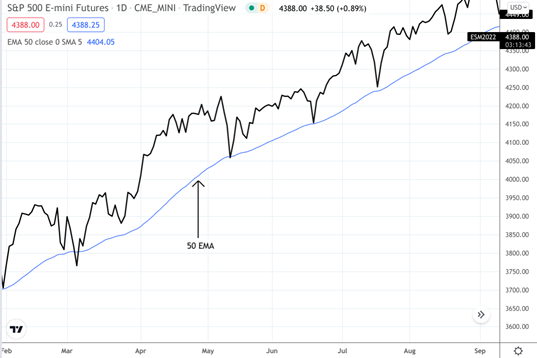When you tune into financial media, you’ll often hear some chartist say that price is above the 50 Exponential Moving Average (or EMA). This means that an asset’s price is still on the up and up. You might also hear that the 50 EMA is above the 200 EMA. This means that the longer-term uptrend is strong.
But here’s the thing: Unless you know what they’re talking about, it all sounds like a bunch of gibberish. So, let’s break it down for you.
What Is An EMA?
Let’s step back and get to the basics. Forget the “exponential” part and just focus on the “moving average” part.
A moving average is an “average” of prices across a number of days; anything greater than 2 days (it can be 5 days, 10, days, 100 days, etc.).
Imagine a candy bar whose price changes everyday. Today it’s $1. The day before that it was $1.10. And three days ago, it was discounted to $0.70. The average price over the last three days is $0.93, or ninety three cents. That’s a moving average.
The “exponential” part is simply a calculation that gives more weight to near-term prices. We won’t get into that. But just know that a lot of traders use it because they think it’s more responsive to near-term price movements.
EMAs Can Help Measure The Strength Of A Trend
The basic idea is that if a moving average is moving upwards, the trend is healthy. So, if the 50 EMA is above the 200 EMA, the trend is…(you got it) healthy. And if the price of an asset is above the 50 which is also above the 200 EMA, then the uptrend is healthy and strong.
That’s the basic idea, at least.

Bouncing Back From the 50 EMA
For some reason, lots of investors think that the 50 EMA acts as “support.” This means they expect the price to bounce back once it reaches the 50 EMA.
There isn’t a solid and proven reason for this, and perhaps it’s a self-fulfilling prophecy, but it tends to happen. So the 50 EMA is one potential price level at which to buy a dip.
The caveat is that an asset can sink well below it, especially if the fundamental picture looks bearish. So, be careful and don’t expect a bounce back each time. Set your stop loss accordingly, and don’t seem shocked if the market disagrees with you.
And even if price does bounce back, it doesn’t mean that the upward momentum will continue. It can always fail. So, once again, set your stop loss in case it does.
The Takeaway
The 50 EMA can make a good “technical” buy point for an asset whose price is falling. But it doesn’t always work, so be prepared for either outcome.
Please be aware that the content of this blog is based upon the opinions and research of GFF Brokers and its staff and should not be treated as trade recommendations. There is a substantial risk of loss in trading futures, options and forex. Past performance is not necessarily indicative of future results.
Be advised that there are instances in which stop losses may not trigger. In cases where the market is illiquid–either no buyers or no sellers–or in cases of electronic disruptions, stop losses can fail. And although stop losses can be considered a risk management (loss management) strategy, their function can never be completely guaranteed.
Disclaimer Regarding Hypothetical Performance Results: HYPOTHETICAL PERFORMANCE RESULTS HAVE MANY INHERENT LIMITATIONS, SOME OF WHICH ARE DESCRIBED BELOW. NO REPRESENTATION IS BEING MADE THAT ANY ACCOUNT WILL OR IS LIKELY TO ACHIEVE PROFITS OR LOSSES SIMILAR TO THOSE SHOWN. IN FACT, THERE ARE FREQUENTLY SHARP DIFFERENCES BETWEEN HYPOTHETICAL PERFORMANCE RESULTS AND THE ACTUAL RESULTS SUBSEQUENTLY ACHIEVED BY ANY PARTICULAR TRADING PROGRAM.
ONE OF THE LIMITATIONS OF HYPOTHETICAL PERFORMANCE RESULTS IS THAT THEY ARE GENERALLY PREPARED WITH THE BENEFIT OF HINDSIGHT. IN ADDITION, HYPOTHETICAL TRADING DOES NOT INVOLVE FINANCIAL RISK, AND NO HYPOTHETICAL TRADING RECORD CAN COMPLETELY ACCOUNT FOR THE IMPACT OF FINANCIAL RISK IN ACTUAL TRADING. FOR EXAMPLE, THE ABILITY TO WITHSTAND LOSSES OR TO ADHERE TO A PARTICULAR TRADING PROGRAM IN SPITE OF TRADING LOSSES ARE MATERIAL POINTS WHICH CAN ALSO ADVERSELY AFFECT ACTUAL TRADING RESULTS. THERE ARE NUMEROUS OTHER FACTORS RELATED TO THE MARKETS IN GENERAL OR TO THE IMPLEMENTATION OF ANY SPECIFIC TRADING PROGRAM WHICH CANNOT BE FULLY ACCOUNTED FOR IN THE PREPARATION OF HYPOTHETICAL PERFORMANCE RESULTS AND ALL OF WHICH CAN ADVERSELY AFFECT ACTUAL TRADING RESULTS.